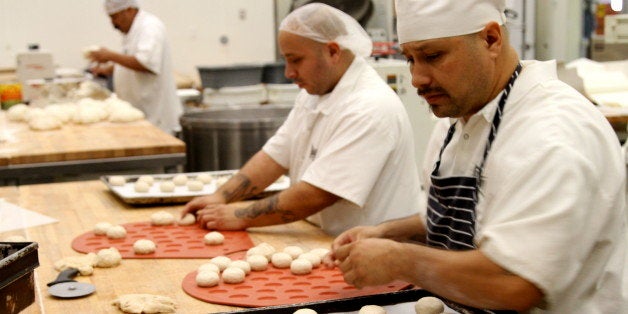
From 1988 to 1998 -- known to some as the “decade of death” -- close to a thousand people per year were killed in Los Angeles. Gangs didn’t run all the neighborhoods, but the ones they did, they terrorized. Drugs moved openly on street corners, drive-by shootings occurred with dispiriting frequency, and wearing the wrong color T-shirt on the wrong street could be interpreted as a death wish.
It all seems improbable now. There are still terrible parts of the city, where brutality and blight reign, but to say that LA is a city unchanged is to ignore the statistics. From 2008 to 2012, violent crime across the nation went down about 16 percent, according to a recent cover story on the subject for Pacific Standard magazine. But in Los Angeles that drop was notably more precipitous in gang areas, the magazine notes: 30 percent in Compton, 50 percent in Bell Gardens and 50 percent in El Monte. Gang-related homicides in Los Angeles have gone down 66.7 percent over the past eight years, and gang-related crimes have seen a 55.3 percent dip since 2005.
So, what accounts for this drastic decline? The only thing that everyone -- from police representatives to community organizers to Sam Quinones, the author of the Pacific Standard piece -- can agree on is that there’s no single answer. But if you consider the six theories below, and how they interact and build on each other, you can begin to see why city officials say Los Angeles hasn’t been this safe since the Eisenhower administration.
1. More police, smarter policing.
When New York City’s current police chief, William J. Bratton, took over the Los Angeles Police Department in 2002, he quickly added 1,000 new cops. But they weren’t brought on merely to bust heads. As Pacific Standard noted, the department's new mantra became: "We can't arrest our way out of the problem."
Bratton strongly encouraged cops to get involved in the lives of the people they were policing, even tying officers' career advancement to their success in community outreach. The result was that division commanders became community problem-solvers, lobbying on behalf of residents for city services such as pothole repair and tree trimming.
The other thing Bratton brought in besides a change of attitude and more boots on the ground was CompStat -- a program that offers real-time statistical monitoring of criminal activity. CompStat has helped shift commanders figure out where to deploy resources. It has also allowed higher-ups to monitor the effectiveness of individual division captains in reducing criminal activity.
2. The RICO effect.
When the Racketeer Influenced and Corrupt Organizations (RICO) Act was enacted in 1970, it was aimed at traditional organized crime groups. It helped break the stranglehold of the Genovese and Gambino Italian mob families, sending John Gotti and many others to jail.
Now, RICO has morphed into an effective tool against street gangs. It allows prosecutors to charge a person even if that person was nowhere near the crime scene, but instead conspired with those who actually did the deed. Plus, a pretrial financial restraining order can be obtained to seize all the defendant's assets and forfeitable property. This prevents the gang from liquidating its ill-gained profits.
The recent shift toward RICO prosecution (the first time it was used against an LA gang happened in 2006) suggests that law enforcement no longer believes in the old kingpin strategy. Instead of assuming that if you lopped off the head of the organization it would fall apart -- which it never did because others just stepped into the leadership role -- RICO puts large chunks of gang soldiers out of commission. Without an army, there is no one to fight the war -- or in the case of gangs, run the street businesses.
The other result of a RICO conviction is that it lands the accused in federal prison, not a California state prison where sentences are more likely to be reduced and inmates are more likely to be paroled. As Quinones wrote in Pacific Standard: "To my eye, the effects of most RICO prosecutions against Southern California gangs have been dramatic, as if a series of anthills had been not just disturbed but dug up whole."
3. Location, location, location.
Since this is Los Angeles we’re talking about, real estate is of course a factor. Rising home prices across the city have changed the demographics of some -- but not all -- of the worst neighborhoods, with new immigrants or young white hipsters now living where Crips once resided. This has made gang neighborhoods less insular and, by extension, less territory-obsessed and violent. Real estate prices have also driven some of the worst players out of town, into places where they don't know as many people or have immediate gang connections. Turns out that it’s harder to be a murderous thug when you’re stuck in traffic on the 405.
4. The decline of the corner boy.
During the "decade of death," street corners in South Central LA were among the most vicious patches of ground in the country. Enter the gang injunction, which made it a misdemeanor for gang members to hang out together in public. As of July 2011, Los Angeles had 44 injunctions against 72 street gangs, according to the LAPD website. The logic behind an injunction is simple. As University of California Irvine criminology professor George Tita told Pacific Standard, “When you don’t have kids hanging out on the street, there’s no one to shoot or do the shooting.”
5. The Mexican Mafia is just way too frightening.
There are supposedly fewer than 300 members of the Mexican Mafia, but they are known for grisly murders, human trafficking and drug dealing -- mostly all orchestrated from behind bars. In 2011, the Mexican Mafia ordered an Azusa, California, street gang under its control to carry out the racial cleansing of all African-Americans from that largely Latino city, according to the U.S. Attorneys Office.
Paradoxically, the Mexican Mafia’s ruthlessness has helped, in part, to clean up the LA gang scene. Quite simply, its violence has scared off prospective members who would otherwise be looking to join other gangs. The specter of Mexican Mafia retribution also changes the behavior of criminals in prison. As noted by the Pacific Standard, most prisoners who request protective custody in the United States are Latino gang members from Southern California. And the reason? They are afraid of the Mexican Mafia. This, too, comes with a crime-reduction benefit. When these gang members are sent to remote prisons in places like Oklahoma and Idaho, they are cut off from their criminal connections back home.
6. Intervention over suppression.
Kaile Shilling, the executive director of the Violence Prevention Coalition of Greater Los Angeles, insists that some of the credit for the reduction in gang violence belongs to the city’s network of community and faith-based groups, as well as the services now being provided by public schools. “LA hasn't just relied on suppression strategies,” she says. “Support has been just as important."
When it comes to intervention programs, few have been more successful than Homeboy Industries, which helps keep about 15,000 former inmates a year from returning to street life. Homeboy Industries provides job training and gives ex-gang members jobs in Homeboy businesses, such as its cafe or grocery store. It also provides tattoo removal services, parenting classes, and free legal and substance abuse counseling. "We provide an exit ramp from street life," the organization's founder, the Rev. Greg Boyle, told The Huffington Post. "Community always trumps gangs."
A switch in how to discipline kids at public schools has also proved highly successful. Previously, kids were expelled for willful defiance. Now, with greater admission that those expelled kids were just getting into bigger trouble outside the school yard, there are more after-school programs, wellness clinics and aide workers on campuses in place to help them. The result is that more kids are getting help before they cross the law. It’s a relatively small change, but put together with all the rest, it has helped make Los Angeles one of the great urban success stories of the early 21st century.
